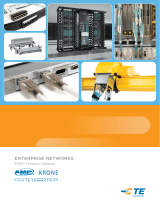
CAUTION: Fiber optic cable is sensitive to excessive pulling, bending, and crushing forces. Consult the
cable specication sheet for the cable you are installing. Do not bend the cable more sharply than the
minimum recommended bend radius. Do not apply more pulling force to the cable than specied. Do not
crush the cable or allow it to kink. Doing so may cause damage that can alter the transmission characteristics
of the cable; the cable may have to be replaced.
2.1 Safety Glasses
2.2 Safety Gloves
2.3 Chemical Precautions
2.4 Laser Handling Precautions
2.5 Cable Handling Precautions
2. Precautions
CAUTION: Recommend the use of safety glasses (spectacles) conforming to ANSI Z87, for eye protection
from accidental injury when handling chemicals, cables, or working with ber. Pieces of glass ber are
very sharp and have the potential to damage the eye.
CAUTION: The wearing of cut-resistant safety gloves to protect your hands from accidental injury when
using sharp-bladed tools and armored cable is strongly recommended. Use extreme care when working
with severed armor. There will be a sharp edge where armor is cut. To minimize the chance of injury from
the cut armor, cover the exposed edge with a wrap of electrical tape. To minimize the chance of injury
from sharp-bladed tools, always cut away from yourself and others. Dispose of used blades and armor
scrap properly.
WARNING: Isopropyl alcohol is ammable with a ashpoint at 54°F. It can cause irritation to eyes on
contact. In case of contact, ush eyes with water for at least 15 minutes. Inhalation of vapors irritates the
respiratory tract. Exposure to high concentrations has a narcotic eect, producing symptoms of dizziness,
drowsiness, headache, staggering, unconsciousness, and possibly death.
CAUTION: Recommend the use of safety
glasses (spectacles) conforming to ANSI Z87,
for eye protection from accidental injury when
handling chemicals, cables, or working with
ber. Pieces of glass ber are very sharp and
have the potential to damage the eye.
WARNING: Never look directly into the end of a ber that may be carrying laser light. Laser light can
be invisible and can damage your eyes. Viewing it directly does not cause pain. The iris of the eye will not
close involuntarily as when viewing a bright light. Consequently, serious damage to the retina of the eye
is possible. Should accidental eye exposure to laser light be suspected, arrange for an eye examination
immediately.
WARNING: DO NOT use magniers in the
presence of laser radiation. Diused laser light
can cause eye damage if focused with optical
instruments. Should accidental eye exposure
to laser light be suspected, arrange for an eye
examination immediately.
Standard Recommended Procedure 004-154-AEN | Issue 2 | January 2023 | Page 3 of 13














